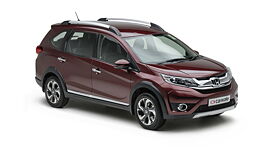Introduction

Given that the compact SUV segment in India is already quite a crowded field, the overall competition is bound to intensify all the more when Honda India brings out the much-awaited BR-V for the masses. The BR-V is Honda’s new Mobilio-based seven-seater compact SUV that combines the utility of an SUV with the practical interiors of an MPV and is set to hit the showrooms by mid-2016. When launched, it will take on two of the hot sellers in this field namely the Hyundai Creta and the Renault Duster.
Looks

The new BR-V is loosely based on the Mobilio but with a longer wheelbase, wider front and rear track. The compact SUV also sits higher off the ground compared to the Mobilio. Design wise, the BR-V takes inspiration from other Honda models as its appearance somewhat echoes the CR-V and even the Mobilio. The vehicle boasts of a window-line that gets an interesting kink on the rear door just like in the Mobilio. In profile, the BR-V looks like a jacked up station wagon, but there are a few rugged looking bits like the chunky roof rails and the plastic body cladding.

At the rear, the BR-V gets protruding taillights and a boot-mounted single piece reversing lights assembly. What’s worth noting here is the Creta-like lower placement for the license plate holder. Speaking of which, the Creta makes use of Hyundai’s Fluidic design language to draw eyeballs. All in all, the Creta manages to look quite burly and also lends a bit of aggression, thanks to its massive front bumper design, LED-infested sweptback headlights and overall upright stance.

Of all three cars here, however, it’s the Renault Duster that exudes a sense of ruggedness, with its imposing chrome grille, chunky roof rails and massive glasshouse. Seen in profile, the Duster’s high ground clearance, wide wheel arches and body cladding seem fit enough to take the rough terrain.
Interior

The interior design of the BR-V is unlike anything we have seen from Honda India yet. The layered dash looks more upmarket and is unarguably more appealing than that of the Mobilio. That being said, serious Honda enthusiasts will be able to notice the familiar steering wheel and instrument cluster design. As for space and utility, Honda is promising class-leading levels of space and features such as a multi-information display and rear air conditioner between the first and second row seats. Thanks to the raised ride height, the seating position is higher than the Mobilio although the difference is minute. Nevertheless, the BR-V scores high on head and knee room although the shoulder room isn’t as good as the Renault Duster.

The Creta’s interior is full of good quality materials and the amount of features on board is aplenty. The overall design is contemporary but surprisingly, the Creta boasts of a fairly simple layout for the dashboard which makes it all the more easier to get accustomed to. In typical Hyundai fashion, the Creta is loaded with equipment with the top-spec SX (O) variant featuring full-leather upholstery, 60:40 split rear seat, climate control, electrically foldable ORVMs, rear armrest, six airbags, ABS and ESP. While we have come to expect all these features in modern cars, the Creta also offers automatic headlamps, rear view camera, 7-inch infotainment system and a 6 speaker audio system with 1GB of onboard memory as standard. In terms of comfort, the Creta is properly spacious for up to four adults as the narrow cabin makes seating for three full size occupants at the rear quite difficult.

If rear seat space and comfort is your priority, the Renault Duster is hard to beat. Being the widest of the three, the Duster can easily accommodate three adults in the rear and the front seat comfort is right up there with the competition as well. What’s below par is the design and layout of the cabin and a few plastics. The Duster is the oldest car here and by a fair margin – a fact that is immediately apparent once you are settled into the driver’s seat. The ergonomics, for instance, are a bit off and it’s also quite difficult to find the ideal driving position.
Performance

The BR-V uses Honda’s proven drivetrain options that currently power the City and the Mobilio. The former, in fact, will be powered by the 1.5-litre i-VTEC petrol and the 1.5-litre i-DTEC diesel engine options. The diesel motor will be paired to a 6-speed manual gearbox, although what’s new for the BR-V is the availability of a 6-speed manual for the petrol-powered versions. Honda says the power and torque outputs will remain unchanged from the Mobilio but the different mapping plus the gear ratios will be revised to suit the BR-V’s character.

The Creta shares its drivetrain with the Verna, which means it gets the 1.6-litre VTVT petrol, 1.4-litre CRDi diesel and 1.6-litre CRDi VGT diesel. While all the engines power the front wheels via a 6-speed manual gearbox, the top-end diesel also gets an optional 6-speed auto box from the Elantra. As for numbers, the petrol engine is rated at 121bhp and 151Nm of torque while the 1.4 diesel engine is good for 89bhp and 220Nm. Meanwhile, the most potent 1.6 litre CRDi diesel puts out class leading 125bhp of power and 260Nm of torque.
Under the hood of the Duster you will either find a 1.6-litre, four-cylinder petrol or Renault’s popular 1.5-litre K9K diesel engine. The latter can be had in two different state of tunes – 85bhp or 110bhp. The Duster can also be had with all-wheel drive in the higher 110bhp spec while the upcoming facelifted version will add the convenience of an AMT gearbox.

Summary

If we go by recent sales figures, it’s the Hyundai Creta that’s head and shoulder above the relatively old Renault Duster. However, it’s the impending attack from the Honda BR-V that the Creta has to fend off and going by the looks of it, the BR-V should be a fitting rival. We will have to wait until mid-2016 to see how well Honda India positions the BR-V in order to cash in on the ever growing demand for compact SUVs.
































